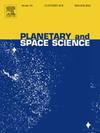Rolling stones on Titan
IF 1.7
4区 物理与天体物理
Q3 ASTRONOMY & ASTROPHYSICS
引用次数: 0
Abstract
On Saturn's moon Titan the unique combination of low gravity, low-density surface materials (ices), and high atmospheric density may enable the wind to roll pebble, cobble, and perhaps even small boulder-size stones. If so, Titan's aeolian environment would be unlike that of Earth or Mars where wind is generally limited to transporting sand and dust much less than a couple of millimeters in size. To investigate the rolling-stone possibility we conducted a mathematical analysis constrained by conventional engineering and aerodynamic theory. We show that the minimum wind strength to cause saltation of sand on Titan is sufficient, under certain geological conditions, to also roll stones as large as ∼0.5 m diameter. Various features previously mapped on Titan have characteristics consistent with fields of wind-rolled stones, with the most compelling candidate being radar-bright ‘streak-like plains’ that are elongated parallel to nearby linear dunes. Possible implications for Titan science and the Dragonfly mission are considered.
土卫六上的滚石乐队
在土星的卫星土卫六上,低重力、低密度表面物质(冰)和高大气密度的独特组合可能使风卷起鹅卵石,鹅卵石,甚至可能是巨石大小的小石头。如果是这样的话,土卫六的风成环境将不同于地球或火星,在地球或火星上,风通常被限制在携带小于几毫米大小的沙子和灰尘。为了研究滚石的可能性,我们在常规工程和空气动力学理论的约束下进行了数学分析。我们表明,在一定的地质条件下,土卫六上引起沙子跳跃的最小风强度足以滚动直径约0.5米的石头。以前在土卫六上绘制的各种特征与风卷石头的特征一致,其中最引人注目的候选者是雷达上明亮的“条纹状平原”,它与附近的线性沙丘平行延伸。考虑到泰坦科学和蜻蜓任务可能产生的影响。
本文章由计算机程序翻译,如有差异,请以英文原文为准。
求助全文
约1分钟内获得全文
求助全文
来源期刊

Planetary and Space Science
地学天文-天文与天体物理
CiteScore
5.40
自引率
4.20%
发文量
126
审稿时长
15 weeks
期刊介绍:
Planetary and Space Science publishes original articles as well as short communications (letters). Ground-based and space-borne instrumentation and laboratory simulation of solar system processes are included. The following fields of planetary and solar system research are covered:
• Celestial mechanics, including dynamical evolution of the solar system, gravitational captures and resonances, relativistic effects, tracking and dynamics
• Cosmochemistry and origin, including all aspects of the formation and initial physical and chemical evolution of the solar system
• Terrestrial planets and satellites, including the physics of the interiors, geology and morphology of the surfaces, tectonics, mineralogy and dating
• Outer planets and satellites, including formation and evolution, remote sensing at all wavelengths and in situ measurements
• Planetary atmospheres, including formation and evolution, circulation and meteorology, boundary layers, remote sensing and laboratory simulation
• Planetary magnetospheres and ionospheres, including origin of magnetic fields, magnetospheric plasma and radiation belts, and their interaction with the sun, the solar wind and satellites
• Small bodies, dust and rings, including asteroids, comets and zodiacal light and their interaction with the solar radiation and the solar wind
• Exobiology, including origin of life, detection of planetary ecosystems and pre-biological phenomena in the solar system and laboratory simulations
• Extrasolar systems, including the detection and/or the detectability of exoplanets and planetary systems, their formation and evolution, the physical and chemical properties of the exoplanets
• History of planetary and space research
 求助内容:
求助内容: 应助结果提醒方式:
应助结果提醒方式:


